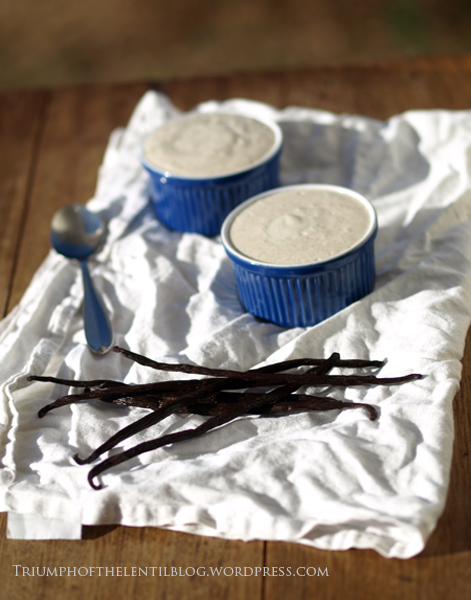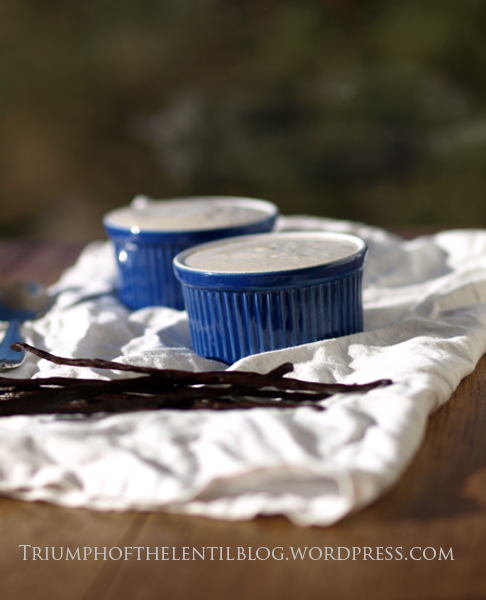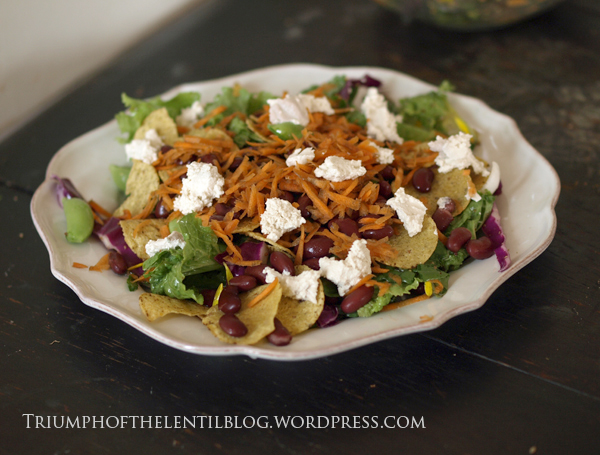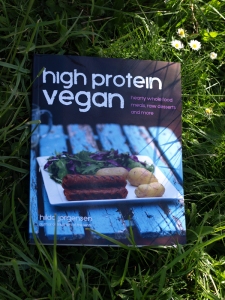Blog Archives
Spiralised Carrot and Chickpea Pad Thai, plus a spiraliser review
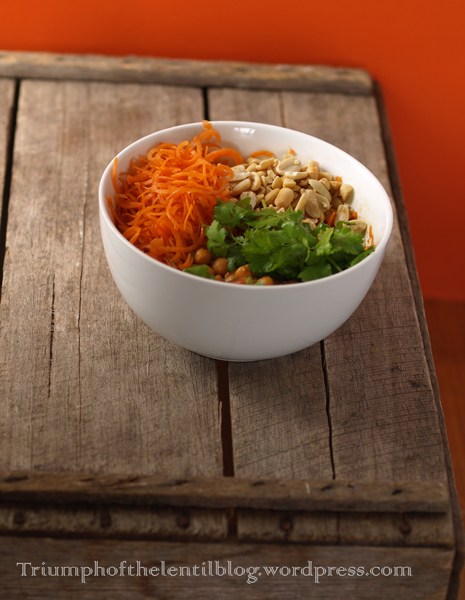 My second book (High Protein Vegan) already has a recipe for a grain-free pad Thai, but seeing as I didn’t have any cabbage on hand, didn’t have the time to make a batch of soy-free tofu and I now have a magical veggie pasta maker, I thought I would try making a different version.
My second book (High Protein Vegan) already has a recipe for a grain-free pad Thai, but seeing as I didn’t have any cabbage on hand, didn’t have the time to make a batch of soy-free tofu and I now have a magical veggie pasta maker, I thought I would try making a different version.
This new recipe is just as delicious as the original recipe, I don’t even miss the crispy bits of fried soy-free tofu. The raw carrot noodles add a nice crunch to the dish and go really well with the sweet, sour and spicy pad Thai sauce.
If you cook for people that prefer to eat wheat noodles instead of spiralised veggies this recipe can still be made without fuss – first bring some water for their pasta to the boil, prepare all the ingredients while waiting for the water to boil and cooking the pasta (I use wholemeal wheat spaghetti, it takes 9 minutes), then when the pasta is cooked, sauté the onions and heat up the chickpeas and sauce.
Put layers of pasta with half the chickpea/sauce mix in one bowl and roughly mix together, do the same thing with the spiralised carrot and the rest of the chickpea mixture. Top the bowls with peanuts and coriander (add some mung bean sprouts if you have those on hand too) and enjoy.
Serves 2
soy-free*, gluten-free*, sugar-free**, grain-free*, under 45 minutes
Ingredients:
For the sauce:
•zest of half a lime or lemon
•juice of 1 1/2 limes or lemons
•2 tablespoons coconut sugar, or unrefined cane sugar such as rapadura or sucanat
•1 tablespoon coconut aminos, miso, tamari or naturally fermented non-GMO soy sauce
•2 tablespoons water
•1/2 a large fresh chilli, finely chopped (or 2 teaspoons minced chili from a jar, or cayenne pepper, to taste)
•optional (but highly recommended if you’re using lemon instead of lime) 1 teaspoon tamarind purée (tamarind pulp/tamarind concentrate)
•optional pinch or two of salt, to taste (recommended if using coconut aminos)
•4-5 spring onions (green onions), finely chopped
•1 1/2 cups cooked chickpeas
•4 medium carrots per serve (400g/14oz) (or use less if you’re not as hungry than I am – most recommendations for the amount of spiralised veggies per serve are 1 or 2 carrots or zucchinis, which I find is not filling enough)
or 100-150g (3.5-5.3oz) dry wholemeal noodles such as spaghetti per serve
•1/3 cup chopped peanuts
•optional handful or two of finely chopped coriander leaves (cilantro)
•optional 1 cup mung bean sprouts
Method:
If you’re boiling pasta for someone, start boiling the water first, and prepare the ingredients while it boils and then cooks the pasta.
Combine all the sauce ingredients in a bowl, set aside until needed.
Heat some olive or sesame oil in a frying pan over medium-high heat. When the oil is hot, add the spring onions and sauté until fragrant, a couple of minutes. Add the chickpeas and the pad Thai sauce and bring to the boil, stirring often, until the sugar has dissolved and the chickpeas are hot.
Put layers of spiralised carrots (or cooked noodles) in bowls, top with a layer of the chickpea mixture and roughly stir to combine, repeat until all the noodles and chickpea mix have been used. Top with the peanuts and coriander leaves and enjoy.
*this depends on your choice out of coconut aminos, miso, tamari or soy-sauce.
**For sugar-free option use coconut sugar.
And now for the spiraliser review:
I’ve been wanting to make raw pasta for years but never got around to it until recently because there are so many spiralisers around now and I wasn’t sure what one to get. Reading other people’s reviews of spiralisers isn’t much help because most people have only tried out one of them and are inclined to say that it works for them so must be the greatest spiraliser around. After doing some research about which ones are available in Australia, I chose the Benriner vertical slicer from Kitchenware Direct.
This spiraliser is the same one that is known as the ‘Cook Help’ in other countries. It’s made in Japan, it feels really sturdy and as though it’s made to last. It is simple to use, I didn’t even need the amusing instructions. It comes with 3 different blades for different sized spiralising (the middle one is my favourite for most veggie pastas), and it only takes around 30 seconds to change the blade, and not much longer to clean it. The time it takes to spiralise enough veggies for a meal for 2 is less than it takes to boil spaghetti.
As you can tell from the recipe above, I’m not restricted to the most well known raw pasta of spiralised zucchini (which is only in season here for around 3 months of the year), but have found that carrot can get really good results in some recipes. Beetroot can be spiralised and made into a delicious salad with a balsamic and olive oil dressing – topping this with some cooked lentils and cultured nut cheeze makes for an easy protein-rich meal.
Since getting this spiraliser I’ve been eating even more vegetables than usual and enjoying some raw pasta meals. A few times I’ve spiralised some daikon radish and carrot used that in place of the kelp noodles from the almond sesame noodle recipe from Practically Raw, I also added some peas for extra protein, even without the capsicum in the original recipe this was great, the sauce has so much flavour.
One concern I had about spiralisers is the amount of waste. Some of the horizontal spiralisers leave a core in the vegetable that can’t be spiralised, so if you only have small vegetables it can waste quite a lot of them Watching this video had convinced me that the Benriner vertical spiraliser was the one to get.
Another thing I like about this spiraliser is that it doesn’t take up much bench space or cupboard space. I also like the green colour, which means it doesn’t stain from spiralising carrots like I imagine some of the white spiralisers might.
When I got this I had no idea I would be using it so much – pretty much every day I have been making a veggie pasta meal, side salad or garnish with the spiraliser. I’ll post the link again, if you’re in Australia and want to buy one: here. I’ve ordered from this shop several times and the orders always arrive quickly and in good condition.
Creamy Vanilla Bean Chia Custard
I seem to be working on quite a few different cookbooks at the moment, which may mean that it will be some time before this wonderful recipe is in print. I will be nice and share it on here now.
This is a healthy and filling snack or dessert with the delicious taste of real vanilla and a decadent creamy mouthfeel. It takes very little actual kitchen time – just put a couple of ingredients on to soak for a while, then add some extra ingredients and blend it up.
Gluten-free, soy-free, under 45 minutes option
Kitchen time 5 minutes
Serves 2
Ingredients:
3 tablespoons chia seeds
6 tablespoons raw cashews
1 1/2 cups vegan milk (for best results use homemade unsweetened almond, cashew or sunflower seed milk)
2 tablespoons agave syrup
pulp from one vanilla bean (or 3 teaspoons high quality real vanilla extract)
a pinch of salt
optional 1/2 teaspoon maca powder
Method:
Combine the chia seeds, cashews and vegan milk in a bowl. Cover and leave to soak in the fridge for at least 10 minutes, preferably over 2 hours or overnight.
Add this to a blender along with the agave, vanilla bean pulp, salt and optional maca powder.
Blend until smooth and enjoy right away, or refrigerate and enjoy later (it will thicken in the fridge).
This post is a part of Wellness Weekend, Healthy Vegan Fridays, Pennywise Platter, Raw Foods Thursdays, Wheat Free Wednesdays,
Nacho Salad
I like to eat salads for meals every now and again, typically if they have plenty of protein, fat and some carbs to make it more filling. This is a salad which has all of these things, but according to my other half it shouldn’t be called a salad, just ‘nachos’. Whatever it’s called, this is a satisfying meal that’s fast and easy to make, and perfect for hot weather.
Total time 10-15 minutes
Gluten-Free, Soy-Free, Nightshade-Free, Onion- and Garlic-Free Option, Under 45 Minutes
Serves as many as you want
Ingredients:
Dressing of your choice (for 2 adults and 2 children I use 3 tablespoons olive oil, 1 tablespoon apple cider vinegar, 1/2 tablespoon raw agave syrup, 1/2 tablespoon seeded or dijon mustard)
Leafy greens (eg. lettuce, rocket (arugula), miners lettuce, mizuna, mustard greens)
Heartier raw vegetables (eg. cabbage, kale, grated carrot, sugar snap peas, green beans)
Optional fresh herbs such as oregano and coriander leaves (cilantro)
Corn chips, or extra grated carrot
Cooked or sprouted beans
Optional extras such as avocado, vegan cheese, salsa, spring onion (green onion)
Method:
Mix the dressing in a large mixing bowl. Add the greens, veggies and herbs and toss to thoroughly coat. Put layers of the dressed salad, corn chips, beans and any extras on large plates and serve right away.
In the photo I’ve used lettuce, rocket (arugula), sugar snap peas, red cabbage, grated carrot, corn chips, cooked red kidney beans, and the basic cashew cheese from ‘Artisan Vegan Cheese’.
Raw Caramel Slice, and an announcement
My new book is out – the first ever high protein vegan cookbook, titled ‘High Protein Vegan: Hearty Whole Food Meals, Raw Desserts and More’. It’s available now from the places listed on this page and I’d like to share one of my favourite recipes from it.
To give you an idea of what it looks like in the book:

Raw Caramel Slice
Gluten-Free, Soy-Free, Nightshade-Free, Onion- and Garlic-Free, Under 45 minutes
Kitchen time 10-15 minutes, Setting time: 30-60 minutes
A raw vegan version of an old favourite with a chewy caramel filling and thin chocolate topping, this slice is delicious and tastes a little bit like caramel nougat chocolate bars, only better. It can be made as a slice in a square pan, or as a torte in a round springform tin. For best results use almonds for the base, although walnuts or pecans will also make a great slice.
I recommend using refined coconut oil for this recipe.
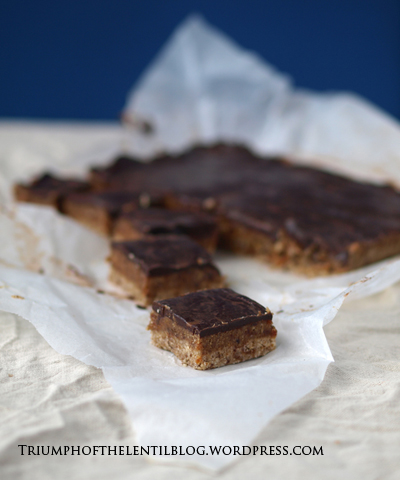
Ingredients
For the base:
1 1/2 cups almonds, walnuts or pecans
a pinch of salt
4 medjool dates, pitted
1/3 cup coconut oil, liquid
For the caramel filling:
18 medjool dates, pitted
2-3 pinches of salt
1/4 cup coconut oil, liquid
1/4 cup nut butter (hazelnut, almond, cashew or brazil nut)
For the chocolate topping:
1/4 cup coconut oil, liquid
a pinch of salt
2-3 tablespoons raw agave syrup
1/2 cup cacao or cocoa powder
Method
To make the base, process the almonds and salt in a food processor until crumbly, but not too fine (some will resemble almond meal, and some will be more like the nut pieces that go into pesto). Add the dates and process until no large pieces remain. Process through the coconut oil until evenly mixed in. Press the mixture into a greased or lined 20cm (8”) square or round baking tray.
To make the caramel layer, process the dates and salt in a food processor until it is finely ground and forms a ball. Add the coconut oil and nut butter and continue to process until thoroughly mixed through (you may need to stop the processor and break up the ball with a fork a couple of times). Press this mixture into an even layer on top of the base.
Prepare the chocolate topping by combining the coconut oil, salt and agave in a bowl. Stir through the cacao and mix until evenly combined, adding more agave if you like. Spread this on top of the caramel layer (you may need to use your hands to spread it) and allow to set at room temperature for at least half an hour before slicing, or until the chocolate topping has set.
What to expect from ‘High Protein Vegan’:
•Innovative ways to serve legumes and vegetables
•Better photos: since writing my first book I’ve learned more about working with natural light and put extra effort into composition and styling, along with upgrading my lens. All the photos in this book are taken with natural lighting.
•Vegan sausages! Bratwurst, Kransky, Frankfurter and more…
•Soy-free tofu, and recipes to use it in
•Raw desserts and raw meals, all without a dehydrator
•All the answers you’ll need for when people ask “where do you get your protein?”
•Recipes to impress anyone, for a variety of occasions
Similar to ‘Triumph of the Lentil’, this book also has:
•Minimal premade products – recipes totally from scratch including laksa and Thai green curry – make meals easily from fresh ingredients, with a taste that is superior to using shop-bought pastes.
•Soy-free options for all recipes. While the book itself is not soy-free in that it doesn’t specify to use soy-free miso or soy-free vegan milks, the soy allergy of my main taste-tester means that all the recipes have been made using soy-free ingredients.
•Mostly gluten-free recipes
•Cook-friendly, frustration-free layout – I like to cook from cookbooks and designed this one with how I want a cookbook to be – easily readable recipes from a distance, with the ingredients and instructions on the same page.
•Colour photos with nearly every recipe
•Whole foods – no refined grains, margarines or ‘fake’ things in sight.
•Index by ingredient – make use of seasonal vegetables and whatever cooked legumes you have on hand
•Recipes suitable for small households – many recipes make 2 servings, while all other recipes make more servings that reheat well or can be stored uncooked in the fridge for cooking up later.
•Lots of everyday recipes – these were all tested with two young children to look after and mostly with ingredients that I can find locally though the whole year. I don’t have the time to spend hours in the kitchen for every meal and have timed every recipe to show just how little hands-on kitchen time some of them take.
•Real meal recipes – This is the stuff I cook at home – not a bunch of appetisers, fancy breakfasts and complicated side dishes but mostly hearty recipes that are either meals on their own, or completed with a very simple side dish.
For more information about the book, see http://highproteinvegan.wordpress.com/
This post has been shared with Allergy-Free Wednesday, Wheat-Free Wednesday, Whole Food Wednesday, Pennywise Platter, Wellness Weekend, Raw Foods Thursdays and Healthy Vegan Fridays
Raw Cashew Yoghurt
We go through times where we don’t have that much variety in our meals, it’s really easy to have a few favourites that can be made through the whole year and always have the ingredients around to make them. Lately I’ve been trying to plan our meals and weekly shopping a bit more so that I can try out new recipes.
I recently got Bryanna Clark Grogan’s book ‘World Vegan Feast’ and dog-eared around half the pages, there are so many recipes that look really good (and the ones that I’ve tried so far have been great). There was one for shawarma wraps that involved yoghurt, so rather than following a faster recipe I decided to use my meal planning skills to make a fermented vegan yoghurt instead.
Ingredients:
1 cup cashews
water, for soaking
1 cup water, for blending
Method:
Soak the cashews in the water for at least half an hour (preferably overnight). Drain and place in a blender with a cup of water and blend until smooth. Using a nut milk bag or a very fine sieve, strain the mixture into a wide-necked jar or bowl. Leave it to sit at room temperature until it tastes fermented. It takes around 24 hours in my fairly cold kitchen, if your kitchen is warmer you might want to check after 8 hours or so.
Compared to shop-bought soy yoghurt this is much creamier, richer, and has a slight cashew taste. Great for any recipe that calls for plain yoghurt, or just served plain with some fruit.
Bryanna Clark Grogan’s recipe consisted of some homemade seitan – slowly baked in broth then thinly sliced and marinated in an incredibly delicious sour and spicy marinade. The seitan is then grilled (broiled) and served in a wrap with salad greens, tomatoes, red onion and vegan yoghurt and sumac. It was very tasty, I will definitely make this again.

This recipe has been a part of the Pennywise Platter, March the 14th
Homemade Saurkraut (raw)
Making saurkraut for the first time can be a little scary – most of the recipes call for at least two cabbages and a special fermenting crock. I wanted to try making it with just one cabbage using equipment that I already had, and this is what I came up with:
I found out about the ‘leave it alone’ technique of releasing juice from the cabbage through The Nourishing Gourmet, in this link she also provides directions for creating a weighted saurkraut without a special crock. The ‘leave it alone’ technique reminds me a little of making slow rise bread, where the slow rise does the job that a time-consuming knead would normally do. Salt is sprinkled on the cabbage and left for at least fifteen minutes, or as long as two hours, and this draws the liquid out in the same way that pounding it with a mallet would normally do.
Really fresh cabbage is important for this – it will make the best tasting saurkraut, and will keep longer in the fridge. I get really fresh local organic cabbage from a market and make this saurkraut on the same day, or the day after.
Quality salt is also essential. I use Himalayan crystal salt, which has larger grains than some other salts. If you’re using a more powdery salt then use less than I do. The best salts for kraut making are raw ones like the Himalayan one I mentioned above, along with Celtic Sea salt, Fleur De Sel and Victorian lake salt. Pure sea salt or pure rock salt will also do, but be sure to check the ingredients to make sure it doesn’t contain any “anti-caking agent” or any other additives.
Equipment needed:
•1 litre (1 quart) wide-mouthed glass or ceramic jar (this is just big enough to hold kraut made from a 1.2kg (2.6lb) cabbage)
•a glass, ceramic or plastic bowl with at least a 3 litre (3 quart) capacity
•1 or 2 wooden spoons, for placing the saurkraut in the jar and tamping it down
•A bowl or plate, for placing under the jar as it ferments
Ingredients:
•1.2kg (2.6lb) cabbage (this will just fit in a 1 litre (1 quart) jar, if in doubt, get a smaller cabbage or a bigger jar)
•salt – I use 2 teaspoons per 300g (10 oz) of cabbage before slicing, plus an extra teaspoon sprinked on top.
Method:
Remove the damaged outer leaves from the cabbage and weigh it. Note down the weight as this will determine how much salt to add.
Cut the cabbage into four wedges. Remove the core from each wedge as shown:
Thinly slice the wedges one at a time, add the first one to the bowl and sprinkle with salt (2 teaspoons per 300g (10 oz)), tossing around with a spoon or two to evenly distribute the salt. Repeat for the other three wedges, then sprinkle with an extra teaspoon of extra salt, for good luck.
Cover with a plate or some other non-metallic cover and leave to sit for at least fifteen minutes, or up to two hours.
Preferably using two wooden spoons, pick up some of the salted cabbage and press it into the jar. Keep adding more and tamping it down with each addition, to get the juice to come out and remove oxygen. Add more and more – the jar will fit a lot of cabbage in it when it’s pressed down, and finally if there is any cabbage juice in the bowl, pour this over the top. There should be a decent layer of brine on the top now, if there isn’t, try tamping it down more, or mix some salt into some water (maybe 2 teaspoons for half a cup) and pour this over the top so that the cabbage is covered.
Put the lid on the jar, place it in a bowl or plate and leave it in a cool dark place (but not too cold) to ferment. After the third day, open and close the lid of the jar every day to let the gas escape. I like how it tastes after four days of fermentation, when the saltiness has mellowed and there is a slight sweet lacto-fermented taste to it, but it is not too pungent. The saltiness mellows more after it’s in the fridge. Many kraut-makers prefer a longer fermentation time (usually around 10 days) but I find with vegan food 4 days of fermenting is fine. When it’s as fermented as you’d like it, move it to the fridge and it will keep well in there for quite a while.
After making one batch of this you might begin to understand why other recipes make such big quantities – it is really tasty, and healthy. Lacto fermented foods such as saurkraut are incredibly healthy and good for digestion. I like to serve saurkraut with shallow fried patties like the mushroom rissoles from Triumph of the Lentil, and a new chickpea patty recipe I’m working on (in the photo below with some red cabbage saurkraut, sweet potato oven chips, salad and homemade vegan mayonnaise). I imagine it would also be awesome with some seitan bratwurst like these ones, maybe served up with some kartoffelpuffer (my recipe is in Triumph of the Lentil).
I am always keen to hear new suggestions on recipes to enjoy saurkraut with, if you have a favourite soy-free vegan dish to serve it with please leave a comment so I can try it!
Raw Vegan Caramel Sundae
This recipe is based around the magic trick of putting frozen bananas in the blender to make soft-serve ice cream. Recently I’ve discovered some raw dark agave nectar that tastes like caramel, along with hulled hemp seeds and found combining these with the ice cream makes a delicious caramel sundae. If you don’t have hemp seeds, any other crushed-up nut would be fine to replace it with. The caramel sauce recipe in this post would be a good replacement for the agave.

To freeze bananas, peel them and place them in the freezer in a container or bag. If you’re in a hurry you can slice them up really small, but I usually just break them in half and leave them in there for at least a few hours. Once they’re frozen they’ll last in there for months, so if you find some cheap bananas this is a quick way to store them for use later in this ice cream, as well as for smoothies and cakes.
Makes 1 big serve, or 2 small
Gluten-free, soy-free, raw
Ingredients:
2 bananas, frozen
1/3 cup vegan milk (use a raw nut milk if you want it to be 100% raw)
2-3 teaspoons dark raw agave or date caramel sauce, for drizzling
hulled hemp seeds, or crushed-up nuts, for sprinkling
Method:
In a blender place the bananas and vegan milk. Leave to sit for a minute (not very long though) and then blend until it resembles soft-serve ice cream. You may need to stir it a couple of times during the blending to help it blend evenly.
Place on your serving dish, drizzle with dark raw agave and sprinkle with hulled hemp seeds. Eat right away.
Raw Pecan Tarts (Vegan Iron Chef Pecan Challenge)

Recently there’s been some recipe challenges in the Goodreads vegan cooking group. With the current challenge being for pecans and some pecans in my kitchen that needed using, I decided to make something raw and delicious with them.
This recipe started out as a raw custard tart, but after making the base and the pecan cream filling, I thought it needed something else, and created a delicious caramel sauce that I would recommend doubling the next time (and maybe halving the pecan cream filling).
Soy-free, gluten-free
Kitchen time 10 minutes. Makes 4.
For the pecan cream (I would recommend halving this):
2 cups pecans
7 dates, pitted
1 vanilla bean
water, for soaking
1 – 1 1/2 cups water, for blending
Soak the pecans, dates and vanilla bean in enough water to cover for at least a few minutes, preferably a few hours. Drain the water (reserving it for blending), remove the vanilla bean, slice it open and scrape the pulp into a blender with the pecans and dates. Add 1 cup of the reserved water and blend on high until combined. Add the extra half a cup of water if you want.
For the crust:
1 1/2 cups pecans
1/2 cup dessicated (dried, finely shredded) coconut
5 dates, pitted
1/4 cup coconut oil, liquid
In a food processor, combine the pecans and coconut. Blend until soft and crumbly. Add the dates and coconut oil and blend until evenly mixed and no big pieces of dates remain.
For the caramel sauce (I would recommend doubling this):
8 dates
1/4 cup pecans
3/4 cup water
1 – 4 pinches of salt, to taste
Place all the sauce ingredients in a blender and leave to soak for at least a few minutes, preferably a few hours. Blend until smooth.
To assemble:
Take 4 12cm (4 3/4″) tart pans and place 1/4 of the crust mixture in each. Press into the base and sides. Pour in 1/4 of the pecan cream into each pan, then decorate with the caramel sauce and some extra pecans.

More recipes from the pecan iron chef challenge:
Rawgust
‘Rawgust’ is an idea promoted by The Raw Food Institute. It involves taking a pledge to go 100% raw for the entire month of August.
I’ve never been 100% raw and like cooked food way too much to consider it so I haven’t signed this pledge, but eating a lot of raw food is great for our health even if we don’t try to have any specific amount of raw food in our diet, so I try to find ways to add more raw food to our lives during the winter.
Raw snacks, like these mostly raw healthy chocolate truffles from Triumph of the Lentil: Soy-Free Vegan Wholefoods for all Appetites are a tasty way to eat more raw food.
There are heaps of raw dessert recipes available online. A lot of chocolate ones are based around a combination of dates, nuts and raw cacao. You don’t really need a recipe to make stuff like this, you can just throw things into a food processor and adjust it to taste, but a good way to start is with 1 1/2 cups of walnuts (or other nut), 1/3 cup of raw cacao and 1 cup of dates (around 12 medjool ones). Process the walnuts until very fine, then mix in the cacao. Pit the dates, then add them to the nuts and cacao and process until evenly mixed. You can roll this into balls, shape it into bars or a cake, or just eat it in spoonfuls out of the food processor. Something I like a lot about raw desserts like this one is that they are often ready right away, so can replace shop-bought muesli bars in a healthier way.
Here are some links to delicious looking raw recipes:
Raw Chocolate Coconut Cupcakes with Avocado Frosting
VegWeb Raw Desserts and Treats
There are plenty more around online if you look for them. Some require hard-to-find ingredients and dehydrators, but a lot of them are really quick and easy to make. Triumph of the Lentil: Soy-Free Vegan Wholefoods for all Appetites has easy recipes for a raw black forest slice, and a raw apricot slice, along with the healthy chocolate truffles in the above picture, which use barley malt syrup or maple syrup as a sweetener, but are otherwise raw.
What are your favourite raw recipes?
